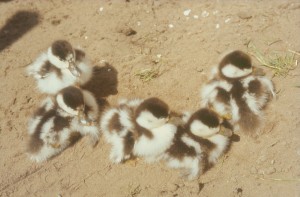Breeding birds at Montrose Basin
We’ve had a range of breeding activities in the Montrose Basin over the last month from the return of unsuccessful breeders to the sight of a large number of ducklings. Both Shelduck and Eider duck ducklings appeared at the beginning of June and they are a good reminder of the very different breeding behaviours found in the avian world.

Shelducks tend to nest in burrows (usually rabbits’) as breeding pairs and while the female does most of the incubating the male remains present and will assistant when needed. This nesting underground is believed to be one of the reasons why the males and females look so familiar as it takes away the nesting females need of camouflage. Once hatched the ducklings are led from the burrow to the nursery area where they are looked after by both parents. This family life will last for around 2 to 3 weeks after which the ducklings form a crèche and most of the adults will leave their young to look after themselves. Montrose Basin’s first Shelduck ducklings were spotted on 8th June and hopefully the numbers will increase over the next few weeks.
Family life is different for Eider ducks. The males play no part in the incubation or care of the hatchlings. Instead eider females nest in colonies and rely on the camouflaging affect of their brown feathers to protect them and their young from predators. Once hatched the ducklings join together to form large crèches watched over by a number of females, but these females are just as likely to be ‘aunties’ as they are mothers. As Eider duck females regularly return to the site at which they hatched colonies tend to be made up of related individuals, leading to this co-operative breeding behaviour which allows the mothers to feed after fasting during incubation.
It’s worth popping down to the Montrose Basin Visitor Centre to get a chance to see these different styles of duckling up-bringing. But it’ll need to be soon, they grow up very fast.
We’ve also had a number of female Goosanders close to the Visitor Centre, with 55 spotted on the 19th June. While they normally live in low density populations it’s not unusual to see this number of individual during the moulting season. These females will have had failed nests, with successful females staying at their breeding sites until August, and have travelled to Montrose Basin and other Scottish estuaries and inner firths to moult. Male Goosanders travel much further, migrating to northern Scandinavia around May/ June to moult, and returning to Scotland around October.
While there was promise of the Common Terns nesting on our raft at the beginning of May, they disappeared on the 10th June with only around ten individuals’ seen visiting on the 17th. This is very similar to the behaviour they displayed last year where they disappeared for a few weeks only to return on the 7th June and breed successfully. There are signs that their first attempts at nesting have failed, with broken eggs being spotted on the raft. However, it is entirely possible that they will nest again, successfully, and we will keep you posted on any changes that occur.
Georgina Bowie
Visitor Centre Assistant
Help protect Scotland’s wildlife
Our work to save Scotland’s wildlife is made possible thanks to the generosity of our members and supporters.
Join today from just £3 a month to help protect the species you love.
Preface
We’ve had a range of breeding activities in the Montrose Basin over the last month from the return of unsuccessful breeders to the sight of a large number of ducklings. …
